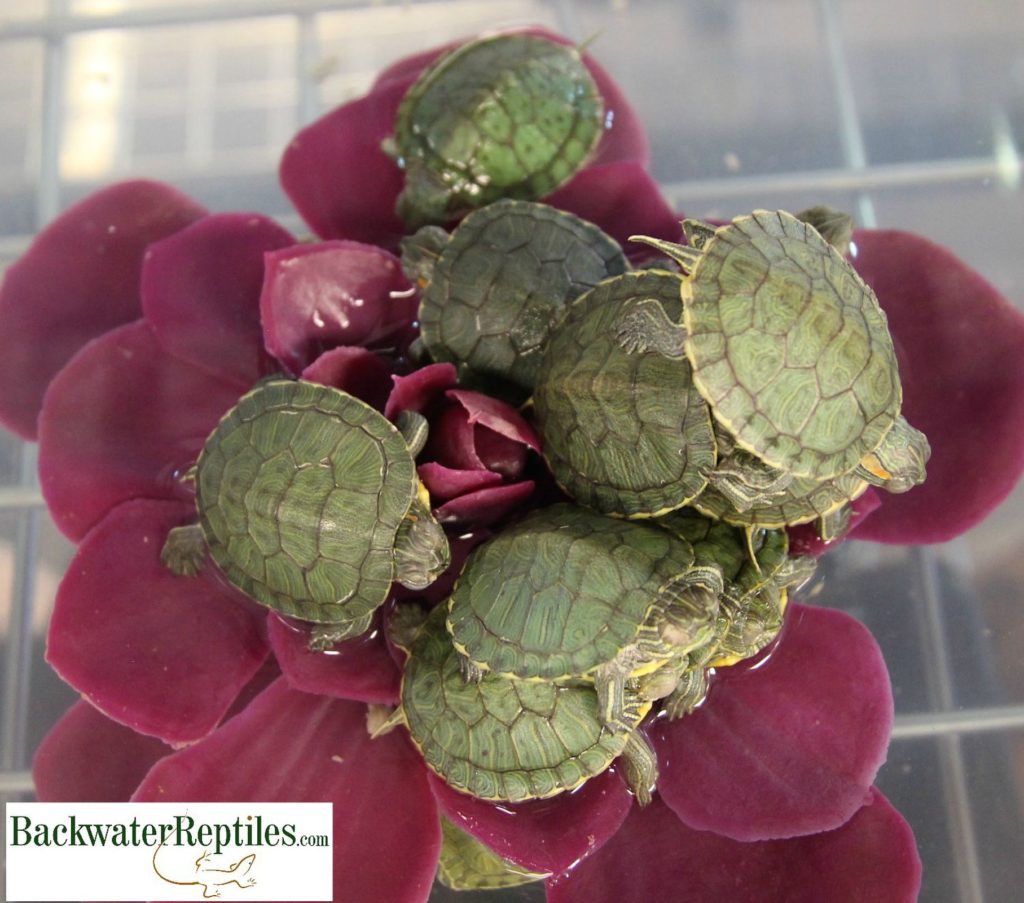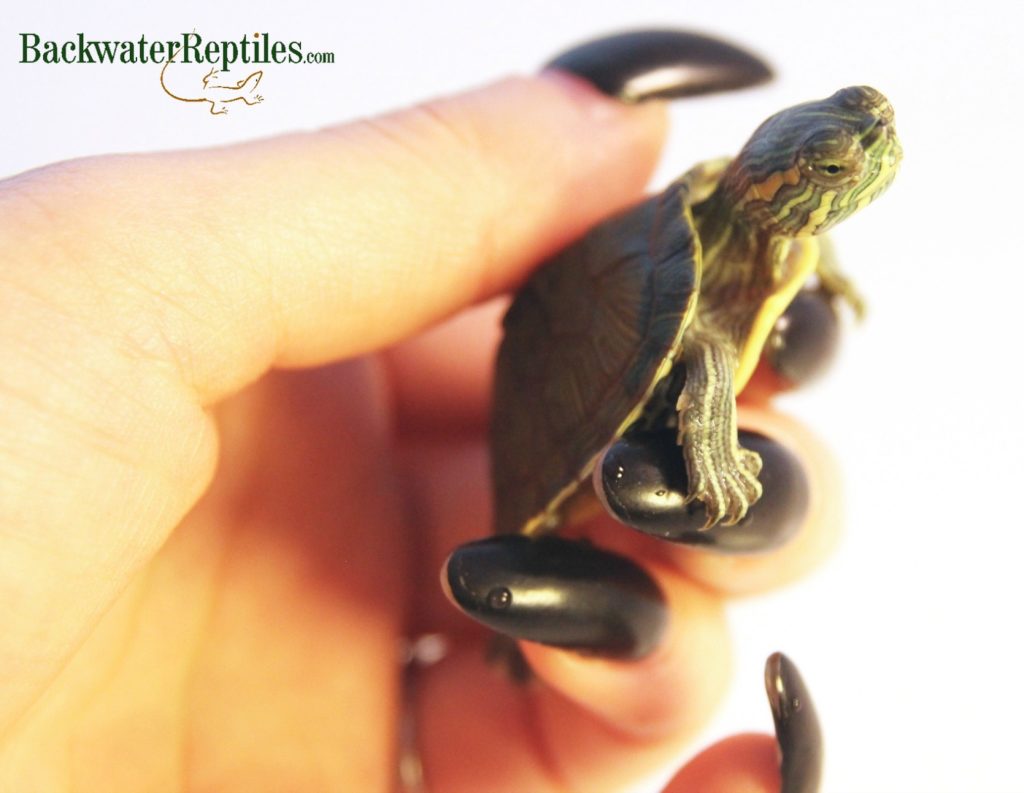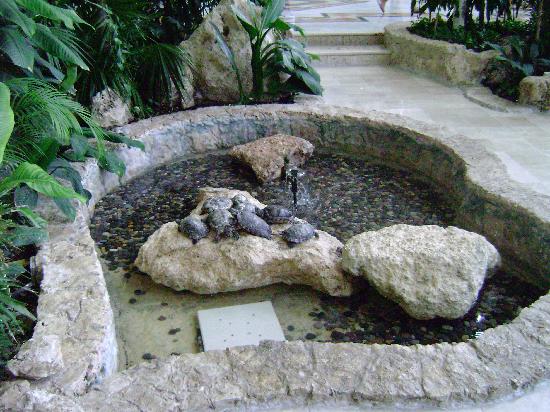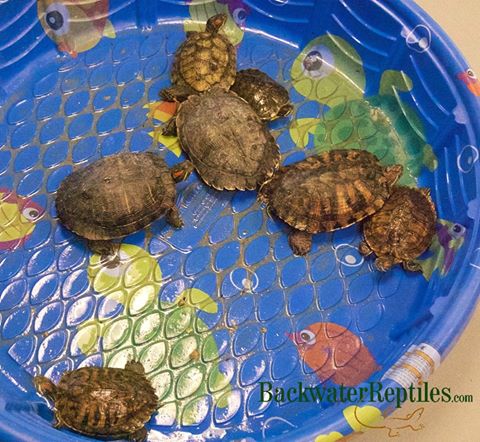Did you know that red eared sliders are one of the most popular species of turtles kept as pets? They are great aquatic reptiles that can be kept in either a tank or an outdoor pond environment, are hardy and versatile, and also quite cute which makes them appealing to both seasoned herp enthusiasts and those just getting introduced to the hobby as well.
Because red eared sliders are so common, we’re dedicating this blog article to discussing how to care for these fantastic turtles. We’ll answer some commonly asked questions such as:
Do red eared sliders make good pets?
What do red eared sliders eat?
What kind of habitat will my red eared slider need?
Can I keep my red eared slider outdoors in a pond?
Are red eared sliders good classroom pets?
So if you’re contemplating getting a pet red eared slider or you already have one and you want to make sure you’re giving it the best care possible, read on!
How to Care for your Red Eared Slider Turtle (Trachemys s. elegans)
Do red eared sliders make good pets?
To sum it up – yes! Red eared sliders make excellent pets, which explains why they are so popular!

Red eared sliders get their common name from the distinctive red mark or stripe behind their eyes where typically an external ear would be found. They range in color and can have shells that are greenish brown, olive green, or even just brown. They always have yellow bellies with irregular markings on their belly scales or scutes.
Red eared sliders can be longer than sixteen inches, however it is far more common to see turtles that range in size from six to ten inches. They are relatively long-lived animals and typically live between twenty and thirty years.
Not only are sliders appealing to look at, they are great outdoor and indoor pets. Many people build fancy ponds in their yards and enjoy watching the sliders thrive in a very natural outdoor environment, while others are content to create aquatic enclosures within their homes. No matter where your slider lives, they are communal creatures and it is entertaining for young and old alike to watch them stack on top of each other while basking, only to scuttle into the water when startled. Funny enough, this habit is actually where the “slider” portion of this turtle’s common name originated.
What do red eared sliders eat?
In the wild, red eared sliders are omnivorous. They eat both protein (meat) and vegetation. Ideally, this omnivorous diet should be replicated in captivity as well, with a good balance being struck between the amount of protein your turtle eats and the amount of plant matter.
Aquatic vegetation and plants that occur naturally in pond environments coupled with dead fish, frogs, and invertebrates are all food items consumed by red eared sliders in the wild. In captivity, in order to ensure a proper diet with all the correct nutrients, many slider owners feed their turtles commercial pellets. But like people, sliders shouldn’t necessarily eat the same thing all the time, so it’s a good idea to offer leafy greens, crickets, roaches, worms, krill, and even pinky mice as treats from time to time. Most sliders aren’t picky eaters and will pretty much enjoy eating anything you feed them.
We recommend that vegetable matter always be available for your turtle to consume when it’s hungry. Protein items can be offered daily, but don’t be alarmed if your slider doesn’t eat them right away. Reptiles have much slower metabolisms than mammals and actually don’t need to eat as frequently.
What kind of habitat will my red eared slider need?
Because red eared sliders are semi-aquatic turtles, you will need to provide them with an aquatic set up, whether you choose to house your turtle(s) indoors in an aquarium environment or outdoors in a contained pond.
Creating an Indoor Habitat
We always recommend keeping hatchlings and juvenile turtles under four inches long indoors. This way you can monitor their diet more closely, keep an eye on them to ensure they don’t escape your yard, and also make sure that no predators manage to capture them.
Indoor aquatic set ups for red eared sliders aren’t very complicated, although because sliders are a messy species of turtle that produce a lot of waste, you will be required to clean the tank fairly often, even with a very good filtration system.

When it comes to setting up a tank for your red eared slider(s), the general rule of thumb is that the enclosure should be able to comfortably hold ten gallons of water for every inch of the turtle’s shell. So, for example, if you have a hatchling slider that is three inches long, your tank should hold at least thirty gallons of water. This might seem like a lot of space for such a small reptile, but keep in mind that red eared sliders are a particularly active species of turtle and they do quite a bit of swimming and spend a lot of time in the water. For this reason, we do recommend making sure that you can provide a home large enough for your adult turtle before you purchase. Considering that at maturity, although rare, very large sliders can be around sixteen inches long, you’ll want to make sure that you are prepared to provide an aquatic enclosure that holds at least 160 gallons of water.
In addition to making sure your tank is the proper size, your turtle’s aquatic set up will require several other elements.
We recommend a good filtration system to help keep the tank clean since we’ve already established that sliders are messy. While a filter is certainly not a replacement for regular cleaning of the tank, it will certainly help keep things as clean as possible between cleanings.
Your red eared sliders will also require a UV lamp. Both UVB and UVA rays are essential to your slider’s health, so make sure your bulbs are full spectrum and mimic the rays of the sun. The temperature of the basking area beneath the lights should be between eighty-five and ninety degrees Fahrenheit.
In addition to a basking light set up, your red eared slider will need what’s referred to as a basking dock. This is essentially an area or platform completely out of the water where the turtles can emerge to dry off and soak up the UV lights. Basking docks can be hand made or purchased at commercial pet stores.
While we have seen aquatic turtle set ups without a water heater, we do still highly recommend purchasing one. Turtles of all species will thrive when the water temperature is consistent. If you keep the water temperature from fluctuating too much, your slider’s metabolism will stay active, making for an overall healthier reptile. Our recommendation for the ideal water temperature is between seventy-five and eighty-five degrees Fahrenheit.
Creating an Outdoor Pond Environment
We highly recommend keeping larger red eared sliders outdoors in contained pond environments, provided the temperatures and weather are appropriate. It is better for the health of the turtle(s) and it is also far less hassle to maintain since large turtles require large bodies of water.
Read on to find out more about how to create an outdoor pond set up for red eared sliders.
Can I keep my red eared slider outdoors in a pond?
As we’ve already touched upon, yes, you can most certainly keep your red eared sliders outdoors in a pond environment! However, please keep these things in mind when you choose to use this housing method:
- Your pond needs to be large enough to accommodate the number and size of sliders that you own. Most turtle pond set ups don’t just have a single turtle living in them, so you’ll want to be sure that your pond is large enough to comfortably contain all your sliders.
- The outdoor temperatures and weather in your area need to be red eared slider friendly. This means that if you love somewhere extremely cold or conversely, extremely hot, you might want to reconsider having a turtle pond.
- Your outdoor pond should be contained. Red eared sliders are active reptiles and they might want to go exploring. You’ll want to be sure that they are unable to go far if they leave the safety of the pond, so backyards with fences are ideal.

When building a turtle pond, you’ll want to protect it from local wildlife, namely any potential predators. Racoons, foxes, and coyotes are often quite threatening to turtles, believe it or not. You can protect your enclosure and help prevent escaping turtles too by setting up a fence or other similar border around the pond.
Another consideration when you build your pond is to make sure that the water is not always in direct sunlight. You will want some form of shade present so that the turtles can thermoregulate and the temperatures don’t get too hot. Essentially, just like you want a hot and cool side for your indoor tank, you will want to fulfill the same requirement for your outdoor pond.
You can go as big or as simple as you want when building your pond. There are so many different options available for budgets and yards of all sizes. You can even include fish and aquatic plants as natural sources of food for your red eared sliders.

The turtles in this photo are all rescues being temporarily housed in a kiddie pool until they are re-homed.
One thing we’d like to stress when it comes to creating an outdoor pond environment is that you need to make sure your pond is secure. Red eared sliders are so hardy and versatile that they have actually become an invasive species in many areas. They can escape yards and wind up interfering with natural ecosystems if you’re not very careful. Please plan your pond’s “security” accordingly. Ideally, no predators should be able to get in and no turtles should be able to get out.
Are red eared sliders good classroom pets?
Red eared sliders can make excellent classroom pets, however please make sure that you are not keeping small turtles in a classroom with children who still like to put small things in their mouth. For this reason, we’d recommend only turtles with shells over four inches long for any classroom.
Sliders are great animals to teach kids responsibility. Not only do they need to be fed a balanced diet, they need to be cleaned up after frequently. Red eared sliders provide a good way to teach children the responsibilities of cleaning up their pet’s waste.
No matter what age group your classroom happens to be, it is important that all children wash their hands after handling the sliders. While most people with healthy immune systems are fine being exposed to the natural bacteria sliders carry, it is always best to be safe. We recommend that any time the sliders are handled by anyone, that person wash their hands with antibacterial soap to kill any potential bacteria such as Salmonella.
Conclusion
Whether you keep a single red eared slider in a tank inside your home or build a fancy outdoor pond habitat for many red eared sliders, know that these turtles are popular pets for a reason.
Red eared sliders are very versatile, hardy, and beautiful reptiles and we guarantee that you and your family will get hours of enjoyment and entertainment from watching them and interacting with them.
Ready for a red eared slider of your own? Backwater Reptiles has sliders of all sizes available for sale.
